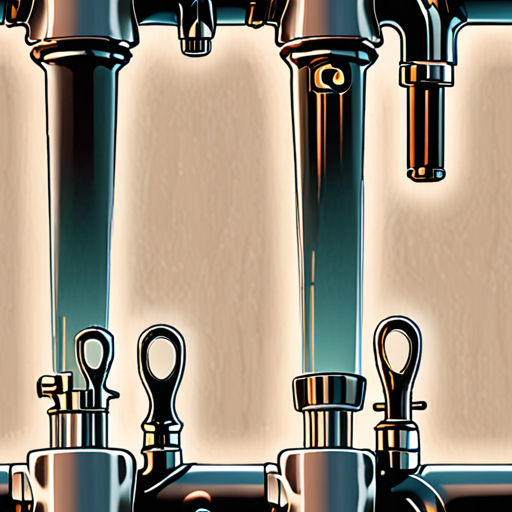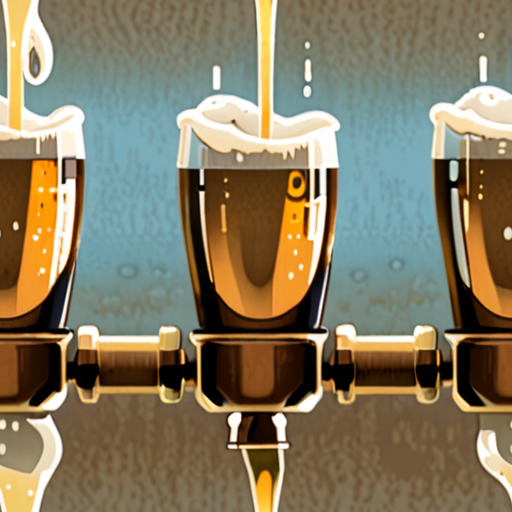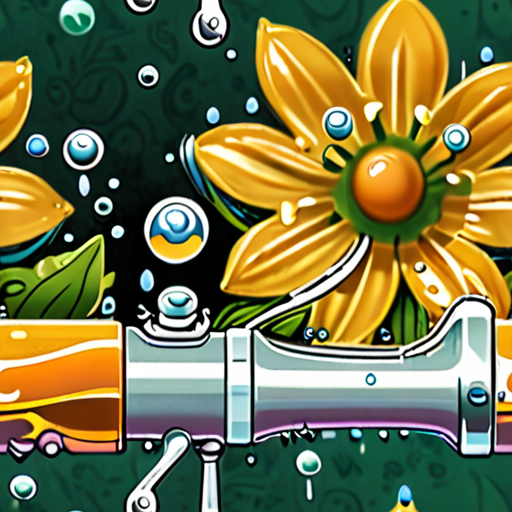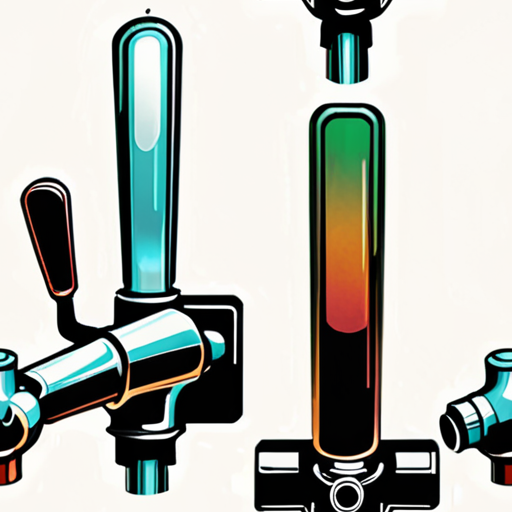Ensuring a safe and enjoyable drinking experience for your customers is crucial for any establishment serving draft beer. However, contaminated beer lines can pose significant risks to public health, leading to unpleasant experiences and even serious health complications. Beer lines, which connect kegs to taps, can harbor bacteria, yeast, and other microorganisms that can contaminate the beer, causing off-flavors, odors, and potentially hazardous situations.

How Often Should I Clean My Beer Lines?
Cleaning your beer lines regularly is crucial to preventing contamination and ensuring a safe drinking experience.
- Why Clean Beer Lines Matter
- Recommended Cleaning Schedule
Clean beer lines are essential for maintaining the quality and integrity of your beer. Over time, beer lines can harbor bacteria, yeast, and other contaminants that can affect the taste, aroma, and overall quality of your beer.
The frequency of cleaning your beer lines depends on several factors, including usage, temperature, and type of beer. As a general rule, we recommend cleaning your beer lines:
- Every 1-2 weeks for high-volume bars and restaurants
- Every 2-4 weeks for medium-volume establishments
- Every 4-6 weeks for low-volume businesses
To keep your beer lines clean and free of contaminants, consider the following tips:
- Always sanitize your beer lines before and after use
- Use a cleaning solution specifically designed for beer lines
- Regularly inspect your beer lines for signs of wear and tear
- Replace worn-out or damaged beer lines promptly
To ensure effective cleaning and maintenance of your beer lines, follow these best practices:
- Turn off the CO2 supply before cleaning
- Disconnect the beer lines from the keg or tank
- Soak the beer lines in a cleaning solution for the recommended time
- Rinse the beer lines thoroughly with water
- Sanitize the beer lines before reconnection
Avoid the following common mistakes when cleaning your beer lines:
- Failing to sanitize the beer lines properly
- Not rinsing the beer lines thoroughly enough
- Using the wrong cleaning solution or equipment
- Ignoring signs of wear and tear on the beer lines
By following these guidelines and best practices, you can ensure your beer lines remain clean and free of contaminants, providing a safe and enjoyable drinking experience for your customers.
Identifying Common Signs and Symptoms of Contaminated Beer Lines
Serving contaminated beer can have severe consequences for your customers’ health and your business’s reputation.
- Off-Flavors and Aromas
- Musty or earthy notes
- Metallic or sour tastes
- Fruity or estery flavors
- Mold Growth
- Black or greenish-black patches on the beer lines or equipment
- Fuzzy or slimy textures on the surface of the beer lines
- Unpleasant odors or musty smells
- Slime or Biofilm Buildup
- Thick, sticky, or gooey textures on the beer lines
- Unpleasant odors or tastes
- Difficulty cleaning or sanitizing the beer lines
- Temperature Fluctuations
- Beer that is too cold or too warm
- Beer that is not carbonating properly
- Beer that is developing off-flavors or aromas
- Equipment Failure
- Leaks or ruptures in the beer lines
- Clogged or blocked beer lines
- Malfunctioning pumps or valves
Contaminated beer lines can impart unpleasant flavors and aromas to your beer, which may be difficult to detect without proper training and equipment.
Common off-flavors associated with contaminated beer lines include:
These off-flavors can be caused by bacteria, yeast, or mold growth in the beer lines, which can lead to spoilage and contamination.
Mold growth is a common sign of contaminated beer lines, particularly in warm and humid environments.
Visible signs of mold growth include:
Mold growth can contaminate the beer and pose serious health risks to consumers.
Slime or biofilm buildup on the beer lines can indicate contamination and compromise the quality of your beer.
Signs of slime or biofilm buildup include:
Regular cleaning and sanitation of the beer lines can help prevent slime or biofilm buildup and reduce the risk of contamination.
Temperature fluctuations in the beer lines can cause stress to the beer, leading to contamination and spoilage.
Signs of temperature fluctuations include:
Monitoring the temperature of the beer lines and maintaining consistent temperatures can help prevent temperature-related issues and reduce the risk of contamination.
Equipment failure can be a sign of contaminated beer lines, particularly if the equipment is not regularly maintained or sanitized.
Signs of equipment failure include:
Regular maintenance and sanitation of the equipment can help prevent equipment failure and reduce the risk of contamination.
To identify these signs and symptoms, it’s essential to monitor your beer lines regularly and take corrective action promptly.
This includes:
- Regularly inspecting the beer lines for signs of contamination or damage
- Cleaning and sanitizing the beer lines regularly
- Maintaining consistent temperatures and pressures in the beer lines
- Repairing or replacing damaged or malfunctioning equipment
By taking proactive steps to identify and address potential issues, you can minimize the risk of contaminated beer lines and ensure that your customers receive high-quality beer every time.

Risks and Consequences of Neglecting Beer Line Cleaning
Neglecting to properly clean and maintain beer lines in a commercial setting poses significant risks and consequences that can impact the quality of beer served, equipment longevity, and ultimately, revenue loss. As a responsible brewery manager or bar owner, understanding these risks is essential to maintaining optimal beer quality and preventing costly issues.
Potential Risks:
- Contaminated Beer: Dirty beer lines can harbor bacteria, yeast, and mold, which can contaminate beer and lead to off-flavors, spoilage, and even health risks for consumers.
- Equipment Damage: Failing to clean beer lines regularly can cause buildup and corrosion, leading to equipment damage, leaks, and costly repairs.
- Lost Revenue: Contaminated beer and equipment damage can result in lost sales, damaged reputation, and decreased customer loyalty.
- Regulatory Compliance Issues: Failure to maintain proper cleaning and sanitation procedures can lead to regulatory compliance issues, fines, and even business closure.
Consequences of Neglect:
- Beer Quality Degradation: Neglecting beer line cleaning can lead to a decline in beer quality, affecting flavor, aroma, and overall consumer satisfaction.
- Increased Maintenance Costs: Failing to maintain beer lines can result in increased maintenance costs, including repair or replacement of equipment, and labor expenses.
- Reputation Damage: Serving contaminated beer or experiencing equipment failures can damage your business’s reputation, leading to a loss of customers and revenue.
- Legal and Regulatory Issues: Non-compliance with regulations and laws can result in legal action, fines, and even business closure.
Best Practices for Beer Line Cleaning:
- Clean beer lines regularly, ideally every 7-10 days, depending on usage and type of beer.
- Use a combination of hot water, sanitizers, and cleaning agents to remove buildup and prevent contamination.
- Monitor beer line condition and adjust cleaning schedules accordingly.
- Train staff on proper cleaning and sanitation procedures to ensure consistency and quality control.
Resources for Beer Line Cleaning:
For more information on beer line cleaning and maintenance, visit our Beer Line Cleaning Guide or consult with a professional brewer or brewery supplier.
Industry Best Practices:
Many breweries and bars have implemented robust cleaning and maintenance programs to ensure optimal beer quality and equipment longevity. Consider visiting Brewers Association or Cicerone Certification Program for industry best practices and guidelines.

Key Factors Contributing to Clogged or Dirty Beer Lines
The cleanliness and functionality of beer lines play a crucial role in serving high-quality beers to customers.
- Improper Cleaning: Failure to regularly clean beer lines can lead to the buildup of bacteria, yeast, and other contaminants, resulting in off-flavors and aromas in the beer.
- Inadequate Flow Control: Insufficient flow control can cause beer lines to become clogged, leading to reduced beer quality and potentially damaging equipment.
- Poor Sanitation Practices: Inadequate sanitation procedures can introduce contaminants into the beer lines, compromising the overall quality of the beer.
- Incorrect Temperature Control: Failing to maintain optimal temperature conditions can cause beer lines to become clogged or dirty, affecting the flavor and aroma of the beer.
- Lack of Regular Maintenance: Neglecting regular maintenance tasks, such as inspecting and replacing worn-out parts, can lead to beer line failures and contamination.
Optimizing Beer Line Maintenance Routine
To minimize issues with clogged or dirty beer lines, implement the following best practices:
- Schedule Regular Cleanings: Set a schedule for cleaning beer lines, ideally every 1-3 months, depending on usage and type of beer being served.
- Use Proper Cleaning Agents: Utilize food-grade cleaning agents specifically designed for beer lines, following manufacturer instructions for safe and effective use.
- Implement Adequate Flow Control: Ensure beer lines are properly sized and configured to prevent excessive pressure and flow rates that can lead to clogging.
- Maintain Optimal Temperature Conditions: Monitor and regulate temperature settings to prevent beer lines from becoming clogged or dirty due to temperature fluctuations.
- Conduct Regular Inspections: Regularly inspect beer lines for signs of wear, damage, or contamination, addressing issues promptly to prevent further problems.
Best Practices for Beer Line Maintenance
By incorporating these best practices into your beer line maintenance routine, you’ll be able to serve high-quality beers to your customers while minimizing the risk of clogged or dirty beer lines.
- Use Food-Grade Cleaning Agents: Select cleaning agents specifically designed for beer lines, ensuring they meet food-grade standards for safety and effectiveness.
- Monitor Temperature Settings: Regularly check and adjust temperature settings to prevent beer lines from becoming clogged or dirty due to temperature fluctuations.
- Inspect Beer Lines Regularly: Conduct regular inspections to identify potential issues before they become major problems, addressing concerns promptly to maintain optimal beer quality.
- Train Staff on Proper Procedures: Educate staff on proper beer line maintenance procedures, emphasizing the importance of regular cleanings, inspections, and temperature monitoring.
Preventing Bacterial Growth and Contamination in Beer Lines
As a craft beer enthusiast, maintaining clean and sanitized beer lines is crucial for delivering a consistently great taste and safe drinking experience.
-
Effective Cleaning Methods:
- Clean beer lines regularly using a mixture of hot water and a sanitizing agent, such as bleach or Star San.
- Use a cleaning solution specifically designed for beer lines, which typically contains a combination of surfactants and sanitizers.
- Rinse thoroughly after cleaning to remove any residue.
-
Reliable Cleaning Schedule:
- Develop a routine cleaning schedule based on usage, with daily cleaning recommended for high-volume establishments.
- Perform deep cleans every 1-3 months, depending on usage and type of beer being served.
- Monitor temperature and pH levels to ensure optimal conditions for beer storage and serving.
-
Prevention Techniques:
- Install a beer line cleaning system, which automates the cleaning process and ensures consistent results.
- Use a beer line sanitizer, which helps prevent bacterial growth and contamination.
- Maintain a clean and organized keg room, with easy access to cleaning supplies and equipment.
By implementing these effective cleaning methods and a reliable cleaning schedule, you can prevent bacterial growth and contamination in your beer lines, ensuring a consistently great taste and safe drinking experience for your customers.
Additional Tips:
- Regularly inspect beer lines for signs of wear and tear, such as cracks or leaks.
- Replace beer lines every 6-12 months, or sooner if damaged or showing signs of wear.
- Train staff on proper cleaning procedures and protocols to ensure consistency and effectiveness.
Best Practices:
- Follow local health and safety regulations regarding food and beverage handling and sanitation.
- Keep records of cleaning schedules and maintenance activities to track progress and identify areas for improvement.
- Continuously monitor and evaluate cleaning processes to ensure effectiveness and make adjustments as needed.

Dirty Beer Lines: Can They Cause Long-Term Health Problems?
The cleanliness of beer lines has become a pressing concern for many craft beer enthusiasts, and for good reason.
- Cleanliness of beer lines is crucial in preventing contamination and spoilage of beer.
- Dirty beer lines can harbor bacteria, yeast, and mold, which can lead to off-flavors and unpleasant aromas in beer.
- Prolonged exposure to contaminated beer lines can result in serious long-term health consequences, including food poisoning and other illnesses.
Risks Associated with Dirty Beer Lines
When beer lines are not properly cleaned and maintained, they can become breeding grounds for microorganisms that can contaminate the beer.
- Bacteria, such as E. coli and Listeria, can thrive in dirty beer lines, posing a significant risk to public health.
- Yeast and mold can also grow in dirty beer lines, leading to off-flavors and unpleasant aromas in beer.
- Prolonged exposure to contaminated beer lines can result in serious long-term health consequences, including food poisoning and other illnesses.
Prevention and Maintenance
To prevent contamination and spoilage of beer, it’s essential to regularly clean and maintain beer lines.
- Cleaning beer lines every 1-3 months is recommended, depending on usage and environmental factors.
- Using a sanitizing solution specifically designed for beer lines can help eliminate bacteria, yeast, and mold.
- Maintaining proper temperature control and humidity levels can also help prevent contamination and spoilage of beer.
Conclusion
In conclusion, dirty beer lines can pose a significant risk to public health, and regular cleaning and maintenance are essential to prevent contamination and spoilage of beer.
By understanding the risks associated with dirty beer lines and taking proactive steps to prevent contamination, we can enjoy our favorite craft beers while minimizing the risk of long-term health problems.

0 Comments